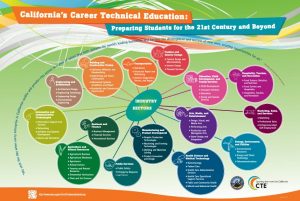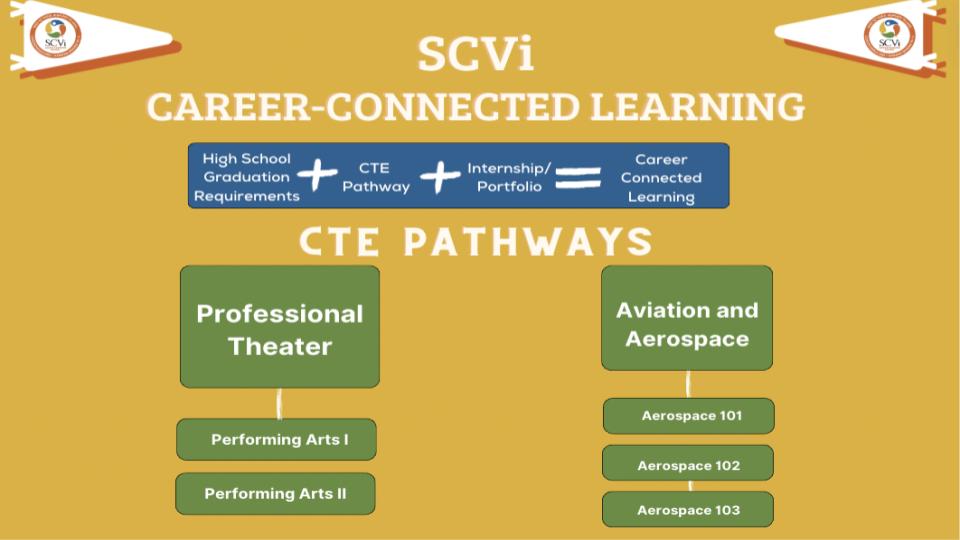What is CTE?
Career Technical Education is a program that integrates high school classes, community connections, work-based learning, and postsecondary planning and training. The goal of CTE is to support learners on their path to high-wage, high skill, in-demand careers in established and emerging industries. CTE is not your mom-and-pop woodshop course. CTE programs connect learners with the skills, mind-set, and knowledge base needed for college and high-demand careers. CTE is personalized. Learners choose their industry sector and the pathway that best aligns with their interests and passions, ensuring the experience is meaningful and relevant to each learner’s goals.

How Does CTE Work?
There are 15 high-demand industry sectors and multiple career pathways within each industry sector. Learners will sign up for a career pathway their freshman or sophomore year of high school and take three years of coursework within that pathway, in addition to relevant internship and work-based learning, student associations and clubs, career and college exploration and preparation, and industry certifications. Learners who complete all three years of coursework receive an additional certificate of completion, recognition at graduation, and postgraduation support. Many CTE courses also count toward the school’s graduation requirements and UC/CSU admissions requirements.
Is CTE just for high school?
Learners experience different industry sectors and career pathways through their projects in 7th and 8th grade. These feeder experiences, or exploratory workshops, allow learners to enter a career pathway in high school with prior experience and confidence in their interest in that pathway. Experiences such as the Glider Project, Entrepreneurship Fairs or Shark Tank projects, Coding and Game Design, school gardening and agriculture, theatre, and photography all have the potential to inspire a learner to work toward that profession through a CTE pathway.
How Is CTE different at SCVi?
Career and Technical education courses are true practice for the project-based real world. Learners use the same principles of iLEAD’s project-based learning model to apply skills and knowledge to real-world problems as they relate to the industry sector of their pathway. This mimics the workplace, gives learners voice and choice, and makes the learning meaningful and fun. Learners step into professional roles, learn work-related skills, and acquire new knowledge through projects that demonstrate necessary competencies for success.
Benefits of CTE:
- High school credits toward graduation and UC requirements
- Potential for college credits earned in high school
- Industry certifications for career
- Internships and work-based learning opportunities
- College/career digital portfolio for college admissions and career opportunities
Current Pathways at SCVi

SCVi’s Career-Connected Learning (CCL) Builds the Leaders of Tomorrow
SCVi offers personalized learning for every student with the intention of allowing each child to follow their passions, hone their skills, and prepare them for as many opportunities as possible postgraduation. What you may know as Career Technical Education, or CTE, at traditional districts is called Career-Connected Learning (CCL) here, because we go so much further than the old-school CTE program.
Here’s how we do that:
Every freshman takes a special course called Freshman Seminar. In this course, learners hone key academic skills to be successful in high school and college, explore their aptitudes as they relate to careers, and experiences each career connected learning pathway at SCVi for hands-on experience.
Sophomores then jump into their path, choosing at least one CCL path at SCVi. We have several paths to choose from:
- Aerospace (3 years of study)
- Performing Arts (2 years of study)
Our CCL pathways help learners in the following ways:
- Provide a reason to come to school. This is where children love to be, which helps them find success in their overall high school experience.
- Provides a portfolio that will help with college admissions and job interviews post-high school.
- Gives opportunities for work-based learning and internship in high school with the industries’ leading experts. We have partnerships with top-level aerospace and arts experts.
- Provides industry-recognized certifications (like Google Python and Drone Pilot License) right in high school. This guarantees that they are employable after graduation and builds confidence to continue learning.
Our advanced learners may also participate in the esteemed and globally recognized International Baccalaureate Programme, which provides opportunities for 5.0 GPA courses, college credits, and an IB Career Pathway (IBCP) Certificate at graduation. This helps support college admissions to top schools and provides more challenge in core courses to those learners who seek that.
To ensure learners feel connected, engaged, and are developing as leaders, our school provides many opportunities outside the classroom:
- Robotics
- Space Competitions
- Drone Soccer
- Student Leadership
- Internships
- Field Studies
- Guest Speakers
- And more
All our learners receive personalized college and career counseling.
And if you’re not yet a parent of a high schooler, don’t fret. Our TK-8 program is designed to support college/career awareness and readiness through exploration of aptitudes and careers through projects and electives designed to kindle interest and skill in each of our CCL pathways.
Contact us to schedule a tour and experience the SCVi difference for yourself.
If you’re interested in enrolling, please click below:


